Special Report: CocciForum Venice
New Challenges in Intestinal Health Management
Growing flocks without in-feed antibiotic growth
promoters (AGPs) has had its consequences.
One is an adverse impact on intestinal health,
which has contributed to the multifactorial disease
known as necrotic enteritis (NE). Until their use was
discontinued, the contribution of AGPs to the control
of NE was not fully appreciated.
The ban on AGPs was implemented due to concern
that subtherapeutic antibiotics given in poultry and
livestock feed may contribute to antibiotic resistant
infections in people, but it has resulted in more infections
and, ironically, has increased use of therapeutic
antibiotics, underscoring the need to find non-antibiotic
alternatives.
The importance of NE cannot be underestimated.
As nutritionist Bill Dudley-Cash recently wrote in
Feedstuffs, an internationally read trade publication,
"The successful commercial production of [poultry], in
the absence of antibiotics, is dependent on the control
of necrotic enteritis." An increasing number of poultry
consumers worldwide are demanding that their broilers
be grown without in-feed antibiotics and "understanding,
controlling and/or managing necrotic enteritis
are the keys to growing chickens without antibiotics,"
he said.
Dr. Luciano Gobbi, technical service manager for
Schering-Plough Animal Health in Italy, says that NE
can be controlled without routine, subtherapeutic
antibiotics, enabling producers to move a huge step
toward meeting consumer demand for truly antibioticfree
poultry.
Gobbi points out, however, that NE goes hand-inhand
with another enteric disease - coccidiosis -
which damages the intestinal lining, setting the stage
for the overgrowth of Clostridium perfringens - the
cause of NE. "Good control of necrotic enteritis
requires good coccidiosis control," he says.
The quest for antibiotic alternatives for control of
necrotic enteritis as well as coccidiosis has focused
largely on nutrition, management and vaccination.
To further knowledge in the poultry industry on
these topics, Schering-Plough Animal Health recently
organized a seminar near Venice. More than 100 representatives
of leading poultry companies from
Europe, the Middle East and Africa gathered to hear
from experts on non-antibiotic control of intestinal disease.
Participants also had the opportunity to hear
from several producers who are successfully controlling
coccidiosis with vaccination and from a marketing
expert about how to succeed in today's climate.
CocciForum magazine is pleased to present highlights
from the seminar in the articles that follow.
Future approaches for necrotic enteritis control

Necrotic enteritis has become a leading
problem for broiler chicken producers,
but control of the disease is possible
with a combination of vaccines and
microflora modulation, predicted Dr.
Steve Davis, president of Colorado
Quality Research, Inc., a US-based
poultry research company.
In recent poultry industry surveys,
necrotic enteritis was one of the top
five health problems affecting broiler
flocks, said Davis. "It's very much a hot
topic... and it did not become a problem
until we started trying to raise
broilers without in-feed antibiotic
growth promoters."
Davis's organization has conducted
between 30 and 40 studies of necrotic
enteritis and made several interesting
observations. One is that the cause of
necrotic enteritis - the alpha toxin
produced by Clostridium perfringens -
varies widely.
"There's a real difference in the C.
perfringens out there," he said. With
some isolates, just a little administered
in feed will rapidly kill birds. Other C.
perfringens isolates tend not to cause
mortality, but adversely affect weight
gain and feed conversion.
"When we talk about necrotic
enteritis, we have to talk about coccidiosis
control," he continued. It's
much easier to induce necrotic enteritis
if birds have coccidiosis, particularly
the Eimeria maxima variety. Coccidiosis
damages the intestines, providing the
right environment for C. perfringens to
proliferate and for NE to develop.
Ionophore anticoccidials such as
lasalocid, monensin and salinomycin
have antibacterial properties - more
than people realize, he added. "We feel
very strongly that ionophores have
helped prevent necrotic enteritis not by
control of coccidiosis, but because they
have actual [antibacterial] efficacy
against C. perfringens," Davis said.
Ionophores, however, are probably
on their way out due to public pressure
to eliminate the use of all antibiotics in
food animals. Chemical anticoccidials
have no antibacterial effects and therefore
would do little to control NE, said
Davis.
Considering the current situation,
vaccines are the direction of the future
for coccidiosis control and may be used
alone or in rotation with any anticoccidial
to help prevent drug resistance,
he said.
Besides coccidiosis, other factors
that appear to predispose flocks to NE
are poor chicken quality and uniformity.
"We've noticed if chicks are of poor
quality, we have more necrotic enteritis
mortality and more early mortality," he
reported. "The more uneven the birds
are, the easier they succumb to a C.
perfringens challenge. It's always the
smallest chicks that end up being the
first to die."
In addition, faster growing birds
also tend to break with necrotic enteritis
sooner than slower-growing birds,
he said.
"When you get an ideal flock, it's
very difficult to produce necrotic
enteritis," Davis said, adding that it's
possible that some breeds of birds are
more resistant to the disease.
Control of NE in the future may depend
largely on vaccines, partly because the
C. perfringens bacterium has excellent
potential for use as a vaccine antigen,
he said.
Schering-Plough Animal Health has
developed a C. perfringens type A toxoid
vaccine for NE that is currently
being used in the United States. (See
www.netvaxforpoultry.com.) In 2008, it
is expected to be approved for use in
Europe.
Davis pointed out that while the
new C. perfringens type A toxoid may
be new for poultry, the technology is
not new among sheep, cattle and
swine. Because injecting individual
broilers would be impractical and costly,
the toxoid is given to breeder hens,
which then convey passive immunity to
their broiler progeny, he said.
Davis's company tested the toxoid
in broilers that also received a coccidiosis
vaccine for coccidiosis control.
Birds with passive immunity from hens
that had received the NE toxoid had a
significant decrease in NE lesions and a
numerical decrease in mortality compared
to birds not from hens that
received the toxoid. (Figure 1.)
"Passive immunity through vaccination
definitely shows that it has excellent
potential" for control of NE, Davis
said.
To further prevent and control the
disease, "We have to avoid placing
known poor quality chicks on farms
that we know have a high C. perfringens
challenge or repeat necrotic
enteritis farms," he advised.
Improved cleaning and disinfection
programs may help control NE if ways
can be found to kill C. perfringens
spores but not the "good bugs" in the
house, Davis added.
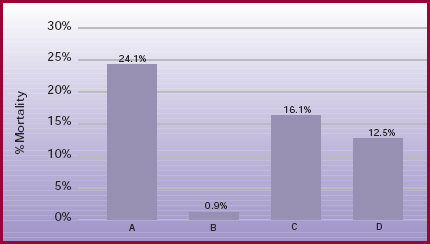
B = Non-challenged control
C = Chicks from hens not given clostridium toxoid and vaccinated day 1 for coccidiosis
D = Chicks from hens given clostridium toxoid and vaccinated day 1 for coccidiosis
Davis has found that diet definitely
can influence NE. The more wheat, rye
and barley fed to chicks, the greater the
toll of NE. High protein levels have
been associated with NE outbreaks.
Animal byproducts, particularly fishmeal,
may be contaminated with
clostridium. Consider that successful
antibiotic-free poultry producers in the
United States tend to use all vegetable
diets, he said.
"I'm not saying we have all the
answers, but it's quite obvious that we
can play with these diets and create
necrotic enteritis," he said.
Davis has also studied feed additives
including enzymes, probiotics
and organic acids. "We have not found
anything that I would say is a magic
bullet."
Nevertheless, "as we learn more
about the natural microflora of the gut,
we're going to get better and better
with these types of products. When
combined with vaccine technology,
we're going to find that it may be possible
to prevent NE without antibiotics,"
he said.
Maximizing intestinal health with nutrition

Nutrition can maximize intestinal health
and help prevent enteric disease, but
deciding which ingredients to use and
finding the right balance of each can
require as much finesse as a high wire
act.
The trend toward growing broilers
with fewer or no in-feed antibiotics is
forcing producers to consider an array
of dietary approaches that may or may
not improve intestinal health and prevent
"dysbacteriosis" - an overgrowth
of "bad" gut bacteria, said Dr. Rob ten
Doeschate, a poultry nutritionist with
Abnatech Global, Peterborough,
England, a consulting and research firm
serving the poultry industry.
"We used to have antibiotic growth
promoters (AGPs). They're gone. We're
still using anticoccidials in the feed and
one by one the list of available anticoccidials
gets shorter, so vaccines will
need to be used," he said.
To help ensure good intestinal
health in light of current trends, it's
more important than ever to begin by
making sure broiler chicks get off to a
good start, ten Doeschate said.
"Chicks need to develop a healthy,
well-functioning gut early in life, so for
the first week, feed very high nutrient
and mineral levels," he said. The
digestible levels of amino acids may be
above breed standards. Sodium is key,
"but don't forget calcium and phosphorous,"
he added.
The diet should also have a good
physical quality to ensure intake and
stimulate gut development. "Nowadays
we use good quality fat and oil almost
exclusively," he said. Too much fat,
however, is bad because lipid digestion
is still underdeveloped.
Young birds need highly digestible
protein. "I don't think that's soy, so I
like to see a bit of fish meal and, if you
can't use fish meal, use some other
purified protein to help the bird the
first couple of days," ten Doeschate
said.
The nutritionist believes that better
intestinal health can be promoted by
encouraging gizzard development,
which can be accomplished by incorporating
some coarse material, such as
whole wheat, into the diet.
In the United Kingdom, whole
wheat is widely used in broiler feeding.
Wheat has been linked to an increased
risk for some intestinal problems but,
according to ten Doeschate, the key is
finding the right amount, which can be
challenging.
Feed trials comparing no wholewheat
dilution with medium and high
levels of added wheat showed that a
high level of wheat resulted in
decreased live weight and poor feed
conversion, but it also resulted in a
lower water intake and fewer hock
lesions. Medium amounts of whole
wheat addition can be positive, ten
Doeschate has found.
Wheat-based diets do result in
increased gut viscosity, "and we
use NSP (non-starch polysaccharide)
enzymes to get over that," ten
Doeschate said.
Besides enzymes, there are several
other "pronutrients" or additives to
consider for broilers raised without
AGPs, he said.
One option is acid salts or organic
acids, which have been used extensively
in breeder feeds to eliminate or control
salmonella. In broiler chicks, their
benefits are not as clear. Trials at
Abnatech have shown that birds tend
to drink more if there's a lot of acid in
the feed, complicating litter management.
"In addition, free acids are corrosive
and therefore are not popular at
feed mills; acid salts are probably less
effective and aren't really the product
for poultry either," he said.
Plant extracts such as essential oils
have been touted as an alternative to
antibiotic growth promoters, but questions
remain about their active ingredients
and quality. "If you get a level in
the diet that will work, it might be so
high that we can't afford it, so it's not
one we've used," ten Doeschate said.
Prebiotics are another option and would include complex carbohydrates such as mannan oligosaccharides from yeast cell walls. Yeast products, he said, have performed well in trials. They are not digested by the bird and improve gut health. Mannoproteins prevent attachment of Escherichia coli and other bacterium to the gut wall and stimulate the immune response, he said.
'The trend toward growing broilers with fewer or no in-feed antibiotics is forcing producers to consider an array of dietary approaches that may or may not improve intestinal health'
The nutritionist is also big on
betaine, which is an "osmoprotectant"
that helps maintain cell integrity.
Studies show that in chickens with coccidiosis,
where the ratio between crypt
depth and villi length decreases,
betaine allows villi to lengthen, resulting
in better nutrient absorption.
"There's an interaction between the
coccidial challenge and betaine in the
tissue. Putting more betaine in the diet
is positive, he said.
Betaine also prevents dehydration
and maintains ionic balance, especially
during times of stress such as transport,
high heat or pathogen challenges. It is
compatible with enzyme function, protects
enzymes and membranes from
osmotic inactivation and improves
water balance, ten Doeschate said.
"Nutrition," he said in conclusion,
"can effect changes in intestinal health
that may be positive or negative. Of
course, it's important to establish a
healthy, good functioning gut during
the starter period. There are more positive
actions we can make in feed
design. Use the right enzyme. We can
minimize changes during the bird's life.
Look at food structure - I'm talking
about coarse grinding. And then last,
but not least, use some pronutrients,"
he concluded.
Top producers share first-hand experiences managing coccidiosis with vaccination
Whether they are smaller nichemarket operations or top industry players, European poultry producers are finding that coccidiosis vaccination is proving to be a problem solver. Vaccination is allowing them to meet market demand for antibiotic-free broilers, combat anticoccidial resistance in conventional flocks, further enhance food safety and simplify flock thinning. Following are success stories from four progressive EU producers.Lloyd Maunder Ltd, UK
Vaccination 'fundamental' to coccidiosis control
At Lloyd Maunder Ltd, a
fully integrated, familyrun
company that's
been producing broilers
in England since the
1950s, coccidiosis vaccination
has become
"fundamental to coccidiosis
control," says
hatchery manager Mike
Tanton.
As a relatively small
company, when competition
with larger
companies in the conventional
broiler market
became difficult, Lloyd
Maunder looked to the
high-value, niche market. In 2000, the company started
growing organic, free-range broilers and now produces
80,000 of them weekly, which it sells in 15 company
shops and to retail outlets, he said.
As part of its new venture, the company developed its
own robust breed of bird, the Devonshire Red, which is
reared to 4 weeks of age in brood houses with high standards
of biosecurity. These high-health birds are then
transferred to mobile houses on the range areas.
Frequently farms have birds of three different age groups
at any one time, presenting tough coccidiosis control
challenges, Tanton said.
The sole method of managing coccidiosis in its organic
chickens is vaccinating with Paracox-5. Chicks are
sprayed at the hatchery when they are one day old. Red
food dye included in the vaccine not only encourages
preening and ingestion of Paracox-5, it marks the chicks,
which lets hatchery staff and farmers receiving the chicks
know that birds are protected against coccidiosis. "The
application is very easy," Tanton said.
"In round terms we vaccinate with Paracox-5 and the
birds don't get coccidiosis. Performance data backs this
up with good levels of production performance" he said.
Lloyd Maunder strives to grow birds slowly and keeps
weight to about 2.25 kilograms (4.9 pounds) as dictated
by market requirements. Slower growth not only helps
produce birds that taste good, it also has reduced mortality,
Tanton said. In organic systems often the main
causes of loss are as a consequence of the more challenging
environment the birds grow in and the effects of
predation
Amadori Group, Italy
Both 'green' and standard broilers benefit from coccidiosis vaccinationParacox-5 has helped
one of Italy's poultry
giants, Amadori Group,
launch its "green and
healthy" Amadori 10+
product, developed in
response to growing
consumer demand for
drug-free products.
Amadori, a fully
integrated company
that produces about
110 million broilers annually, found that after gaining
experience with Paracox-5, it had "very satisfactory technical
results" in its green birds and began using the vaccine
in standard broilers too, said Dr. Tonino Toscani,
director of health and nutrition for Amadori's poultry
business.
In its drug-free birds, use of the vaccine coupled with
good management practices enable birds to maintain
performance similar to birds receiving traditional in-feed
anticoccidials, "which we have demonstrated in many
internal trials," Toscani said.
In standard broilers, the vaccine is used primarily to
combat rising coccidial resistance to anticoccidial drugs
and chemicals. "We hope to ensure greater choice of
effective anticoccidial products for the future by rotating
the vaccine with medicated feed," he said.
Toscani showed data demonstrating that after three
cycles of using the same ionophore anticoccidial, the
number of resistant Eimeria coccidia rises. When
Paracox-5 is rotated with anticoccidials, ionophore resistance
decreases because the vaccine's live, attenuated
Eimeria oocysts replace resistant oocysts.
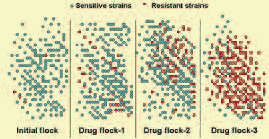
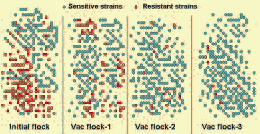
Isolates of European field coccidia, including some
taken from it's own poultry units, have shown that complete coccidial resistance and reduced sensitivity to the
in-feed anticoccidials monensin and diclazuril are widespread
on farms that strictly use in-feed anticoccidials for
coccidiosis control, Toscani added.
In contrast, "our experience suggests that a rotation
program that includes at least two or three consecutive
vaccinated flocks followed by two or three medicated
flocks on the same premises restores sensitivity to standard
anticoccidial drugs," he said. In standard flocks,
Amadori now usually uses in-feed anticoccidials during
winter, which helps reduce the impact of wet litter, and
the coccidiosis vaccine in late spring and summer.
No acute disease outbreaks
"Performance results are better than expected," Toscani
said, yielding not only good coccidiosis control with no
cases of acute disease, but improved feed conversion.
He attributes some of Amadori's success with the vaccine
to genetic improvement and feed management.
Energy and protein in the diets have been reduced to
control enteric problems. In the future, enteric disease in
birds vaccinated against coccidiosis may require a dedicated
control strategy; medication may be occasionally
needed in vaccinated birds as well as in those receiving
anticoccidials.
Necrotic enteritis control will also require new strategies
in brooding management, diet manipulation and
vaccination when it becomes available. Bird density and
water quality are other factors that need to be considered,
Toscani said.
Note: For more about Amadori's experiences with coccidiosis
vaccination, see CocciForum No. 8 or go to
www.ThePoultrySite.com/CocciForum.
Martini Alimentare, Italy
Coccidiosis vaccination simplifies feed management, saves money
One of the major Italian
poultry producers
Martini Alimentare
has found that Paracox-
5 significantly simplifies
management in flocks
that are thinned, a popular
practice in Europe.
Martini, an integrated
company with six
feed mills and three
slaughterhouses
throughout Italy, produces
15 million broilers
annually.
Dr. Corrado Longoni,
a poultry field veterinarian
with Martini, explained that males and females are
placed in the same house but are divided by a fence.
Females are usually thinned at ages of 35 to 37 days
because they have less efficient feed conversion rates.
Another thinning might be done for heavy females or
light males, usually at 44 to 46 days of age.
After each thinning, practiced in accordance with animal
welfare regulations, the fence is moved to give more
space to a greater number of faster-growing, large-breasted
males that are processed at weights of 3.3 or 3.4 kilograms
(7.2 or 7.4 pounds) and, sometimes as high as 4.5
or 4.6 kilograms (9.9 or 10.14 pounds), he said.
Thinning makes it possible to send birds from each
group for processing at different ages, depending on
market demand. Thinning makes it easier to raise very
heavy birds throughout the year, especially during summer
months when there is heat stress and higher density
could be detrimental. In addition, thinning enables
producers to capitalize on economies of scale, since
house space is used more efficiently and more kilos of
meat per square meter can be produced. All players in
the production chain benefit from increased profits,
Longoni said.
Medication omplicates thinning
The use of in-feed synthetic or ionophore anticoccidials
and their required withdrawal time, which is usually 5
days, seriously complicates thinning, he said. (Figure 1.)
Anticoccidials have to be withdrawn from feed soon
enough to ensure that meat has no residues, and puts the
flock at risk for a coccidiosis outbreak. Keeping anticoccidials
in the feed increases the risk that residues could
mistakenly end up in meat at a time when consumer
concern about residues is at an all time high. Market flexibility
is hindered and feed management becomes a
logistical nightmare since two or three withdrawal periods
would be needed in thinned flocks, he said.
In addition, "feed mill contamination is a real concern,"
since Martini makes feed for poultry other than
broilers. "We can't take the risk of residues either in feed
for non-target species or in our withdrawal feed for broilers,"
Longoni said.
Vaccinating for coccidiosis eliminates these problems.
It protects against coccidiosis, makes it easier and safer
to thin flocks and enables Martini to be flexible in
response to market needs. Feed management is simplified
since no withdrawal diet is needed, and there are no
headaches about anticoccidial residues in meat or about
cross-contamination, he said. (Figure 2.)
Reduced costs
Paracox-5 has not only improved disease and feed management,
it has saved money in several ways, Longoni
added. Since it enables thinning to be practiced and
house space is used more efficiently, transportation costs
for moving day-old chicks and for transporting live birds
to slaughterhouses are each down by 20% to 30%.
The cost of transporting feed is reduced by 10% to
20% because there is no need for withdrawal feed or for
larger quantities of other feed, although this savings
would vary among producers, he said.
Integrators pay farmers based on the kilograms of
meat per square meter and flock performance, including
the feed conversion ration, the culling rate and meat
quality.
"Increased volume per square meter provides farmers
with reduced fixed costs and provides integrators with
reduced variable costs," Longoni said.
Note: For more about Martini Alimentare's experiences with
coccidiosis vaccination, see CocciForum No. 10 or go to
www.ThePoultrySite.com/CocciForum.
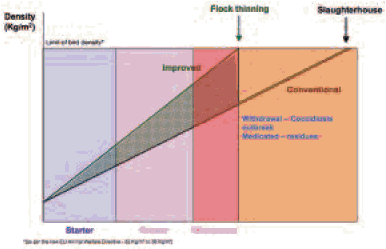
Figure 2. In thinned flocks, Paracox-5 simplifies feed management as well as eliminates concerns about residues in meat.
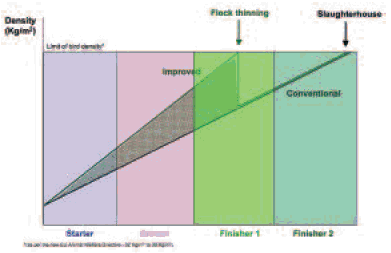
SADA, Spain
Vaccination helps ensure food safety
At Spain's leading
poultry producer SADA
p.a., a vertically integrated
company with
nine hatcheries and 10
processing plants, over
3 million chicks are
placed with contract
farmers weekly.
SADA consumers
want poultry meat that
is safe to eat from
healthy birds raised
with the environment
and animal welfare in
mind, according to
integration manager Dr.
Santiago Bellés Medall of SADA, a subsidiary of the
Netherlands-based Nutreco, one of the world's leading
animal nutrition companies.
Potential hazards in food include biological hazards
such as bacteria, viruses and parasites, physical hazards
such as bones or plastics, and chemical hazards, which
include pesticides, antibiotics and anticoccidial residues.
Each risk must be identified and separate measures taken
to deal with each one. Consequently, SADA has strict
procedures in place to ensure that all potential hazards
are controlled and prevented, he said.
SADA has found that one way to prevent the risk of
anticoccidial residues in poultry meat is by using
Paracox-5, which is administered to about 25% of the
company's flocks. Use of the vaccine especially complements
the practice of thinning flocks, Bellés said.
Thinning, he explained, is practiced on farms with
medium and high density "about 14 and 18 birds per
square meter (10.76 square feet), respectively "and is
based on live weight, not age. About 20% of its birds are
grown to about 1.8 kilograms (3.9 pounds) and the rest
to more than 2.5 kilograms (5.5 pounds).
| Figure 1. Vaccination to control coccidiosis eliminates the need for a withdrawal diet. | |
| Anticoccidials | Withdrawal days |
|---|---|
| Chemical | |
| Robenidine | 5 |
| Halofuginone | 5 |
| Diclazuril | 5 |
| Ionophore | |
| Lasalocid | 5 |
| Monensin | 3 |
| Narasin | 5 |
| Salinomycin | 5 |
| Maduramycin | 5 |
| >Vaccine | |
| Paracox-5 | none |
When anticoccidials are used, managing withdrawal
diets in flocks that each have their own growth rate
requires making several different feeds in small quantities.
Logistics at the feed mill become complicated, as
does the transport of feed and feed management on the
farm because several different feeds have to be juggled,
increasing the risk for errors or cross-contamination, he
said.
It becomes "nearly impossible" to abide by legal
requirements intended to prevent anticoccidial residues,
Bellés added.
With coccidiosis vaccination, the need for a withdrawal
diet is eliminated, which simplifies feed management
and, perhaps best of all, enables SADA to guarantee
that its poultry is free of residues from ionophore
anticoccidials, he said.
Source: Cocciforum issue 14







